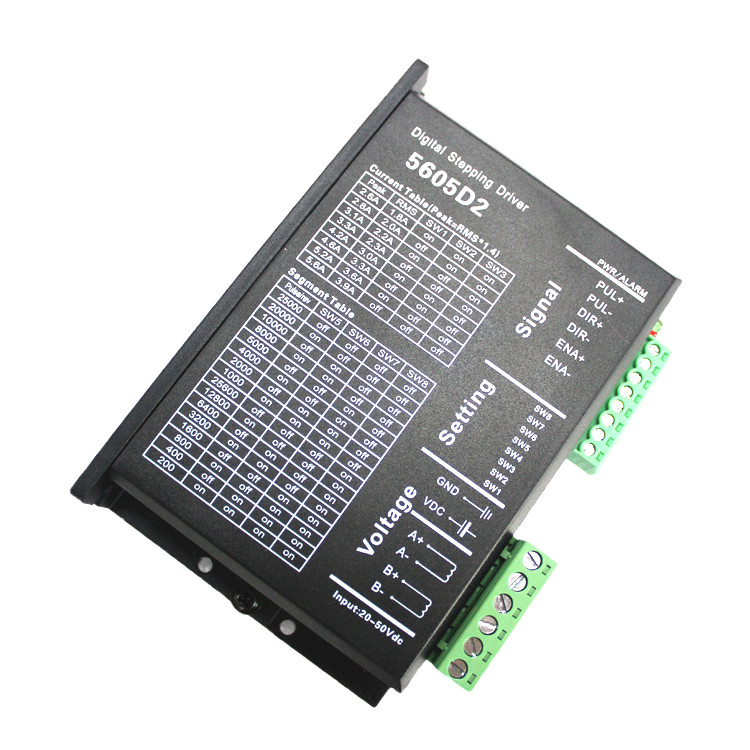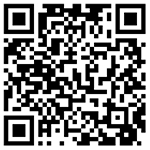A complete stepping system should include stepping motor, stepping driver, power supply and controller (pulse generator). A typical connection is shown as figure 9.
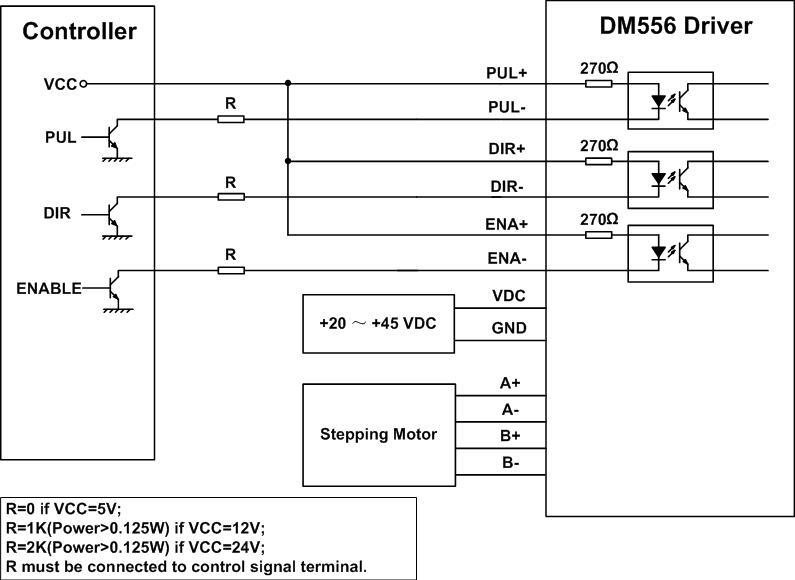
Figure 9: Typical connectio
Frequently Asked Questions
In the event that your driver doesn’t operate properly, the first step is to identify whether the problem is electrical or mechanical in nature. The next step is to isolate the system component that is causing the problem. As part of this process you may have to disconnect the individual components that make up your system and verify that they operate independently. It is important to document each step in the troubleshooting process. You may need this documentation to refer back to at a later date, and these details will greatly assist our Technical Support staff in determining the problem should you need assistance.
Many of the problems that affect motion control systems can be traced to electrical noise, controller software errors, or mistake in wiring.
Problem Symptoms and Possible Causes
Symptoms | Possible Problems |
Motor is not rotating | No power |
Microstep resolution setting is wrong |
DIP switch current setting is wrong |
Fault condition exists |
The driver is disabled |
Motor rotates in the wrong direction | Motor phases may be connected in reverse |
The driver in fault | DIP switch current setting is wrong |
Something wrong with motor coil |
Erratic motor motion | Control signal is too weak |
Control signal is interfered |
Wrong motor connection |
Something wrong with motor coil |
Current setting is too small, losing steps |
Motor stalls during acceleration | Current setting is too small |
Motor is undersized for the application |
Acceleration is set too high |
Power supply voltage too low |
Excessive motor and driver heating | Inadequate heat sinking / cooling |
Automatic current reduction function not being utilized |
Current is set too high |
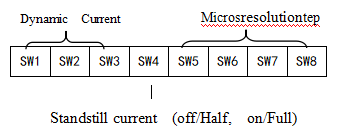
Microstep Resolution Selection
When it’s not in software configured mode, microstep resolution is set by SW5, 6, 7, 8 of the DIP switch as shown in the following table:
Microstep | Steps/rev.(for 1.8°motor) | SW5 | SW6 | SW7 | SW8 |
1 to 512 | 200Default/Software configured | on | on | on | on |
2 | 400 | off | on | on | on |
4 | 800 | on | off | on | on |
8 | 1600 | off | off | on | on |
16 | 3200 | on | on | off | on |
32 | 6400 | off | on | off | on |
64 | 12800 | on | off | off | on |
128 | 25600 | off | off | off | on |
5 | 1000 | on | on | on | off |
10 | 2000 | off | on | on | off |
20 | 4000 | on | off | on | off |
25 | 5000 | off | off | on | off |
40 | 8000 | on | on | off | off |
50 | 10000 | off | on | off | off |
100 | 20000 | on | off | off | off |
125 | 25000 | off | off | off | off |
Current Settings
For a given motor, higher driver current will make the motor to output more torque, but at the same time causes more heating in the motor and driver. Therefore, output current is generally set to be such that the motor will not overheat for long time operation. Since parallel and serial connections of motor coils will significantly change resulting inductance and resistance, it is therefore important to set driver output current depending on motor phase current, motor leads and connection methods. Phase current rating supplied by motor manufacturer is important in selecting driver current, however the selection also depends on leads and connections.
When it’s not in software configured mode, the first three bits (SW1, 2, 3) of the DIP switch are used to set the dynamic current. Select a setting closest to your motor’s required current.
Standstill current setting
The current automatically reduced to 60% of the selected dynamic current one second after the last pulse. Theoretically, this will reduce motor heating to 36% (due to P=I2*R) of the original value. If the application needs a different standstill current, please contact Condriver.
Dynamic current setting
Peak Current | RMS Current | SW1 | SW2 | SW3 |
1.2A | 0.8A | ON | ON | ON |
2.1A | 1.5A | OFF | ON | ON |
2.7A | 1.9A | ON | OFF | ON |
3.2A | 2.3A | OFF | OFF | ON |
3.8A | 2.7A | ON | ON | OFF |
4.3A | 3.1A | OFF | ON | OFF |
4.9A | 3.5A | ON | OFF | OFF |
5.6A | 4.0A | OFF | OFF | OFF |
Standstill current setting
SW4 is used for this purpose. OFF meaning that the standstill current is set to be half of the selected dynamic current, and ON meaning that standstill current is set to be the same as the selected dynamic current.
The current automatically reduced to 60% of the selected dynamic current one second after the last pulse. Theoretically, this will reduce motor heating to 36% (due to P=I2*R) of the original value. If the application needs a different standstill current, please contact Condriver.
The 5605D2 has two connectors, connector P1 for control signals connections, and connector P2 for power and motor connections. The following tables are brief descriptions of the two connectors. More detailed descriptions of the pins and related issues are presented in section 4, 5, 9.
Connector P1 Configurations
Pin Function | Details |
PUL+ | Pulse signal: In single pulse (pulse/direction) mode, this input represents pulse signal, each rising or falling edge active (software configurable); 4-5V when PUL-HIGH, 0-0.5V when PUL-LOW. In double pulse mode (pulse/pulse) , this input represents clockwise (CW) pulse,active both at high level and low level (software configurable). For reliable response, pulse width should be longer than 2.5μs. Series connect resistors for current-limiting when +12V or +24V used. The same as DIR and ENA signals. |
PUL- |
DIR+ | DIR signal: In single-pulse mode, this signal has low/high voltage levels, representing two directions of motor rotation; in double-pulse mode (software configurable), this signal is counter-clock (CCW) pulse,active both at high level and low level (software configurable). For reliable motion response, DIR signal should be ahead of PUL signal by 5μs at least. 4-5V when DIR-HIGH, 0-0.5V when DIR-LOW. Please note that rotation direction is also related to motor-driver wiring match. Exchanging the connection of two wires for a coil to the driver will reverse motion direction. |
DIR- |
ENA+ | Enable signal: This signal is used for enabling/disabling the driver. High level (NPN control signal, PNP and Differential control signals are on the contrary, namely Low level for enabling.) for enabling the driver and low level for disabling the driver. Usually left UNCONNECTED (ENABLED). |
ENA- |
Sequence Chart of Control Signals
In order to avoid some fault operations and deviations, PUL, DIR and ENA should abide by some rules, shown as following diagram:
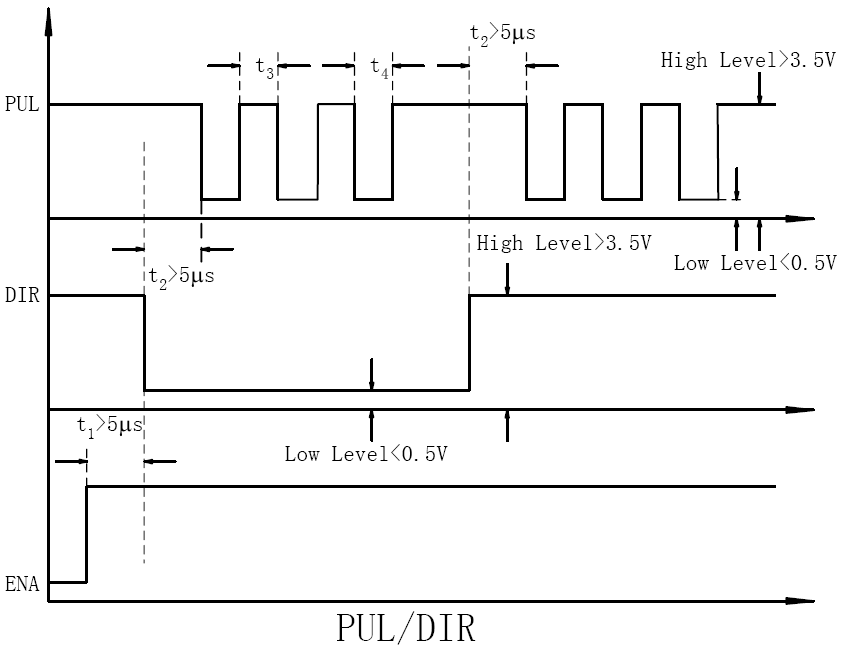
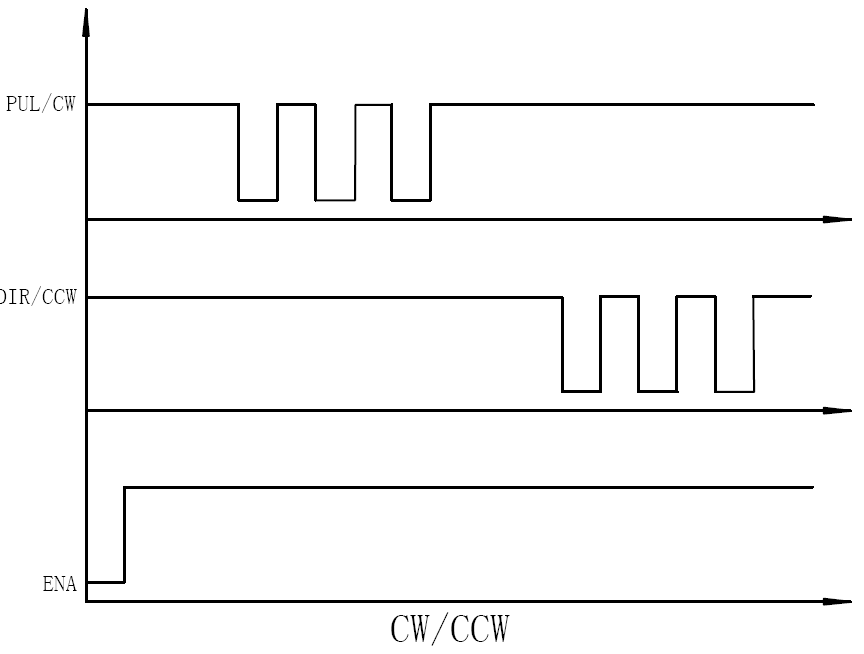
Remark:
a) t1: ENA must be ahead of DIR by at least 5ms. Usually, ENA+ and ENA- are NC (not connected). See “Connector P1 Configurations” for more information.
b) t2: DIR must be ahead of PUL active edge by 5ms to ensure correct direction;
c) t3: Pulse width not less than 2.5ms;
d) t4: Low level width not less than 2.5ms.
Connector P2 Configuration
Pin Function | Details |
+Vdc | Power supply, 20~50 VDC, Including voltage fluctuation and EMF voltage. |
GND | Power Ground. |
A+, A- | Motor Phase A |
B+, B- | Motor Phase B |
Protection Indications
Priority | Time(s) of ON | Sequence wave of RED LED | Description |
1st | 1 | 
| Over-current protection |
2nd | 2 | 
| Over-voltage protection |
Electrical Specifications (Tj = 25℃/77℉)
Parameters | 5605D2 |
Min | Typical | Max | Unit |
Output current | 1.2 | - | 5.6 (4.0 RMS) | A |
Supply voltage | +20 | +36 | +50 | VDC |
Logic signal current | 7 | 10 | 16 | mA |
Pulse input frequency | 0 | - | 200 | kHz |
Isolation resistance | 500 |
|
| MΩ |
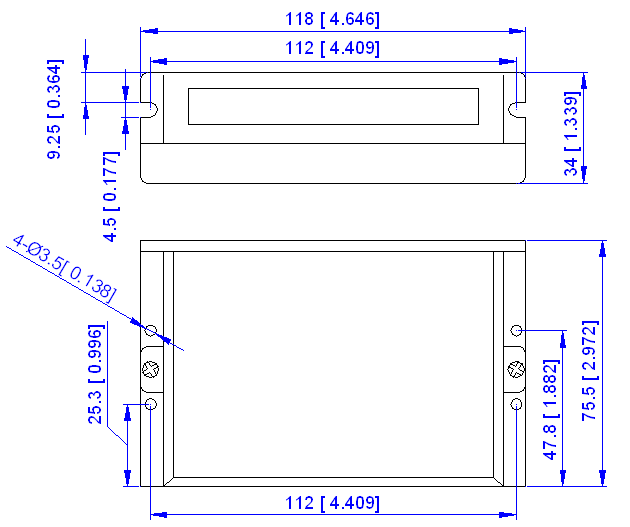
Elimination of Heat
● Driver’s reliable working temperature should be <70℃(158℉), and motor working temperature should be <80℃(176℉);
● It is recommended to use automatic idle-current mode, namely current automatically reduce to 60% when motor stops, so as to reduce driver heating and motor heating;
● It is recommended to mount the driver vertically to maximize heat sink area. Use forced cooling method to cool the system if necessary.
● Anti-Resonance, provides optimum torque and nulls mid-range instability
● Motor self-test and parameter auto-setup technology, offers optimum responses with different motors
● Multi-Stepping allows a low resolution step input to produce a higher microstep output for smooth system performance
● Microstep resolutions programmable, from full-step to 102,400 steps/rev
● Supply voltage up to +50 VDC
● Output current programmable, from 1.2A to 5.6A
● Pulse input frequency up to 200 KHz
● TTL compatible and optically isolated input
● Automatic idle-current reduction
● Suitable for 2-phase and 4-phase motors
● Support PUL/DIR and CW/CCW modes
● Over-voltage, over-curren
Applications
Suitable for a wide range of stepping motors, from NEMA frame size 17 to 34. It can be used in various kinds of machines, such as laser cutters, laser markers, high precision X-Y tables, labeling machines, and so on. Its unique features make the 5605D2 an ideal solution for applications that require both low-speed smoothness and high speed performances.



